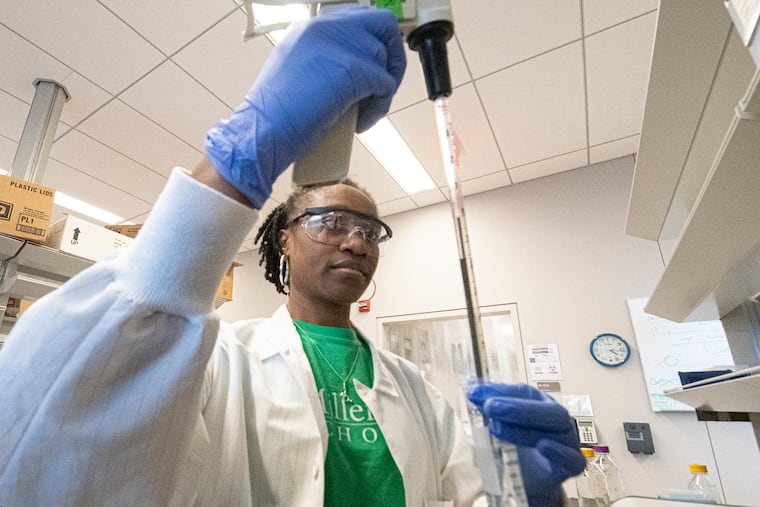Penn State is pushing for more diversity among STEM scholars
Penn State has one of few programs nationally to cultivate more females and students of color for doctoral programs in science, technology, engineering and math.

STATE COLLEGE, Pa. — Ashley Saunders was exposed to the idea of a doctoral degree in chemistry when her high school teacher, who had one, shared her dissertation on quantum physics.
But Saunders, who is African American, said she didn’t see many black female Ph.D. role models in science-focused fields back home in Fairfax County, Va., a suburb of Washington.
“It’s hard to, I guess, pursue a field where you don’t think you would fit before you’re even there,” she said.
The Millennium Scholars program at Pennsylvania State University changed that. The program offers full and partial scholarships primarily to women and students of color for science, technology, engineering and math — the STEM fields — with the goal of preparing them for doctoral programs.
Saunders, 21, is set to receive her bachelor’s in May and is preparing applications for graduate school. The impact of Penn State’s program? “It’s insanely important,” she said.
Penn State started the program seven years ago to address a need for more Ph.D.-level STEM researchers and leaders from diverse backgrounds, including first-generation students and those who struggle to afford college. About half of its participants have gone on to enter doctoral programs.
It’s one of two programs across the country patterned after the successful Meyerhoff Scholars program at the University of Maryland-Baltimore County, which has the distinction of cultivating the most black graduates with both a medical degree and a doctorate, and the second most in STEM doctorates. The other is at the University of North Carolina at Chapel Hill. UMBC worked with both to develop their programs.
At Penn State, about 35 to 40 incoming students are chosen each year. They begin with a six-week summer program, conduct research early on, and live with their cohorts in the same residence hall for at least the first two years.
“Without that support, I would have felt very lost and isolated going to a school like Penn State," which is predominantly white, said Emily Cribas, 24, whose parents are from Honduras.
She got her bachelor’s in biochemistry and molecular biology in 2017 from Penn State and is in her third year of a doctoral program in microbiology at the University of Pennsylvania.
Run on a budget of about $4 million, the program is highly competitive. Penn State receives 600 applications a year. Top candidates come for two-day interviews.
“We look at academic performance to a large degree,” said director Amy Freeman, but also want candidates with a passion for STEM, a commitment to increasing diversity in those fields, and an interest “in contributing to the global condition of the world.”
Scholars are spread among five colleges: Engineering, Science, Information Sciences and Technology, Earth and Mineral Sciences, and Agricultural Sciences.
Of those currently enrolled, more than two-thirds are women, almost four out of every five come from racially underrepresented groups, and more than 80% are from families with financial need. (In-state tuition, fees, and room and board run over $30,000, while out-of-state costs exceed $48,000.) The average graduation rate for bachelor’s candidates is about 80% and the average GPA is 3.6, Freeman said.
Since the university brought in its first group as freshmen seven years ago, 31 have gone on to enroll in doctoral programs. The first are expected to get their Ph.D.s by 2021, Freeman said. Students attend graduate schools around the country.
UMBC’s Meyerhoff program, which started in 1989, has a longer track record. Since inception, about 1,500 have participated, with 1,150 of them graduating (most others are still in school), and more than 90% with a degree in a STEM field, said Michael Summers, who mentors Meyerhoff students at UMBC.
Of the graduates, 930 pursued graduate or professional degrees. The vast majority are from racial minority groups, he said.
Forty have faculty positions at top universities such as Duke, Stanford, and Johns Hopkins, he said. Jerome Adams, the U.S. surgeon general, is a former Meyerhoff scholar.
» READ MORE: New surgeon general's science background was nurtured in Maryland
Freeman knows what it’s like to be the only African American woman pursuing a degree in a male-dominated field. She got her bachelor’s in construction management at Washington State University, then her master’s in architectural engineering and doctorate in workforce education and development from Penn State.
“There were no programs like this. You really were totally alone,” Freeman said.
The Millennium program provides students with academic advising and tutoring.
“You can always get help,” said Alisha Wellington, 20, a sophomore from Philadelphia, who said she has wanted to be a meteorologist since she was 7.
Saunders, the aspiring chemist, is her math tutor.
Scholars are required to meet with program advisers weekly, attend seminars, and participate in research.
“In order to establish more research in fields that affect more minorities, you have to have minorities in those fields to really do the research and call attention to these needs,” Saunders said.
In early November, 24 students went to California to present their work. Others, including Oluwafunke Alliyu, a sophomore from Philadelphia, traveled to Hawaii this fall.
“It was amazing,” said Alliyu, 19, an applied statistics major, “just learning what people are doing in terms of research.”
Research areas range from diseases to prosthetic limbs, and clean water and air and buildings. Students are encouraged to start early.
Another participant, Talayah Johnson of Chicago, recalled being pushed as a freshman to apply for summer research experiences. She was thrilled to meet top scholars who looked like her.
“They kind of normalize the concept of being diverse and getting a doctorate in a STEM field,” Johnson said.
After graduating in May, Johnson is working toward a Ph.D. in biomechanics at Penn State.
That’s the goal, Freeman said. “The future changes because we do this.”